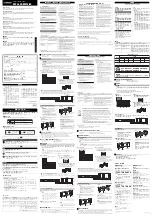
Summary of Important Information
7
CLEAN up spills immediately
per instructions on the chemical label.
TURN OFF power to sprayer, and RELIEVE system pressure
before leaving sprayer unattended.
SEE Troubleshooting section of this manual before attempting any repairs
. Wear personal
protective equipment and follow safety instructions.
After Spraying
CLEAN immediately after use
according to the directions provided in this manual.
DECONTAMINATE yourself after you are
done spraying and have cleaned the spraying system.
Wash all exposed areas of the body with soap and water, and remove and launder clothing.
DISPOSE OF or STORE remaining chemicals in secure storage with correctly marked
container
.
Chemical accident procedures
Immediate response is necessary in the event of sprayer leaks, bodily chemical contact, poisoning, or
spills. See instructions below:
Sprayer leak
If the sprayer develops a leak,
immediately stop spraying
. Turn off power to
the sprayer and follow directions below, as applicable.
Bodily
chemical
contact
Personal contamination can occur when chemicals splash, spill, or spray
directly onto a person.
1. Immediately follow First Aid instructions on chemical label.
General procedures can include:
a) Eyes – immediately flush with water.
b) Skin – wash all contaminated skin surfaces with soap and water.
c) Clothing – remove contaminated clothing. Dispose of heavily
contaminated clothing per chemical label instructions.
2. Seek medical advice if instructed on the label or the victim experiences
symptoms of harmful effects. Bring the chemical label for reference.
Poisoning by
ingestion or
inhalation
In case of poisoning from ingestion or inhalation:
If the victim has collapsed or is not breathing, call 000.
Otherwise:
1. If you are the victim, immediately seek assistance from nearby personnel
because you may become incapacitated.
2. Immediately follow first aid instructions on chemical label.
3. Call a poison control center for further advice.
In Australia. Call 13 11 26
.
Have the chemical label available for reference.
Chemical
spills
Chemical spills must be quickly contained and properly cleaned up.
Refer to the chemical label for any specific clean-up instructions.
General procedures include:
1.
Controlling
the spill by stopping the source of the spill.
2.
Containing
the spill so that it does not spread and get into water sources.
3.
Cleaning up
the spill immediately.
4.
Seeking additional advice
from:
-
Chemical manufacturer
. See chemical label for contact information.
- Contact the APVMA (Australian Pesticides & Veterinary Medicines
Authority), by emailing [email protected] or calling (02) 6210
4701.
Summary of Contents for K16003
Page 1: ...Specifications...
Page 3: ...Hazard Signal Word Definitions 3...
Page 24: ...24 Page intentionally left blank...
Page 25: ...25...








































